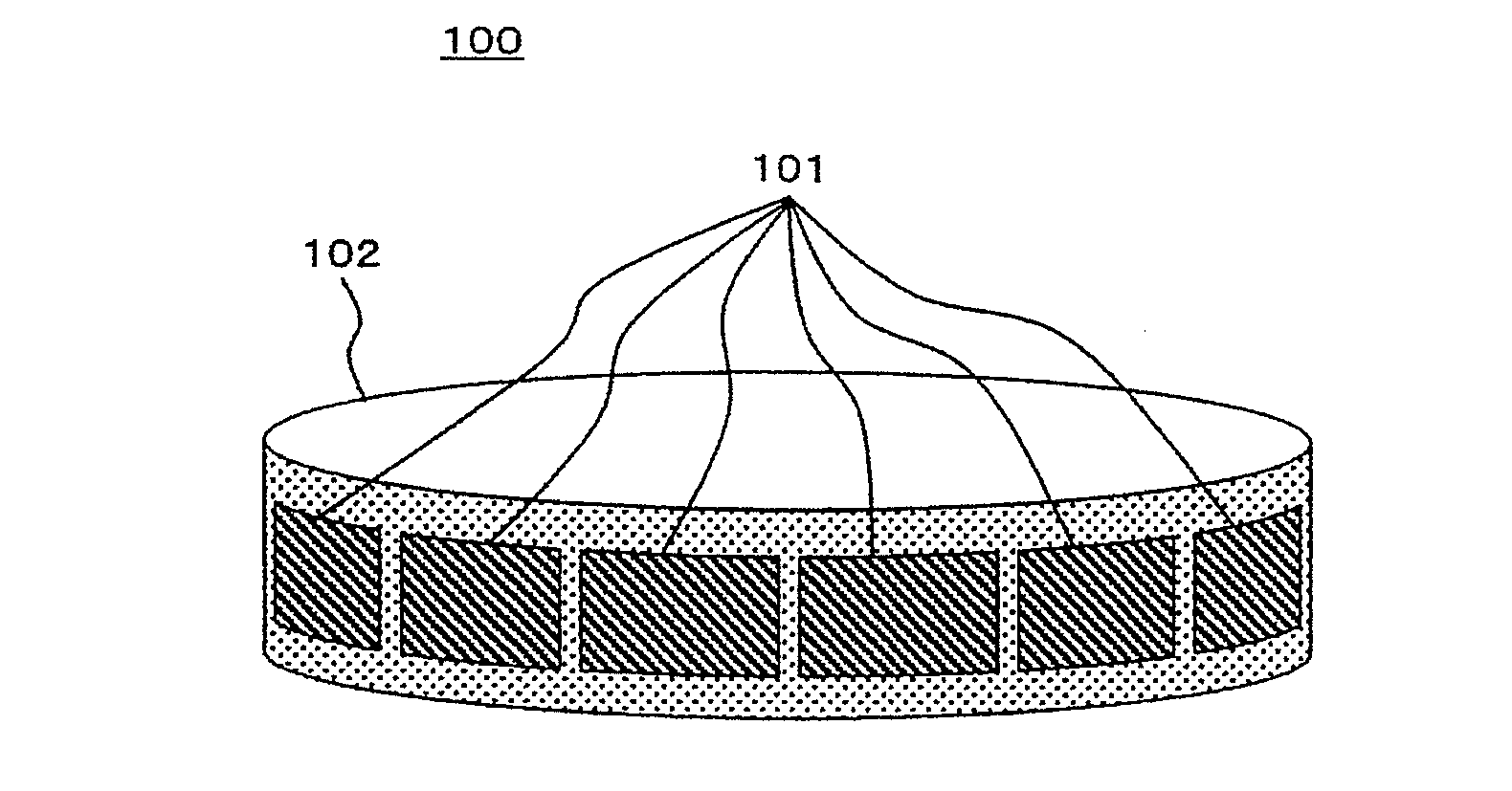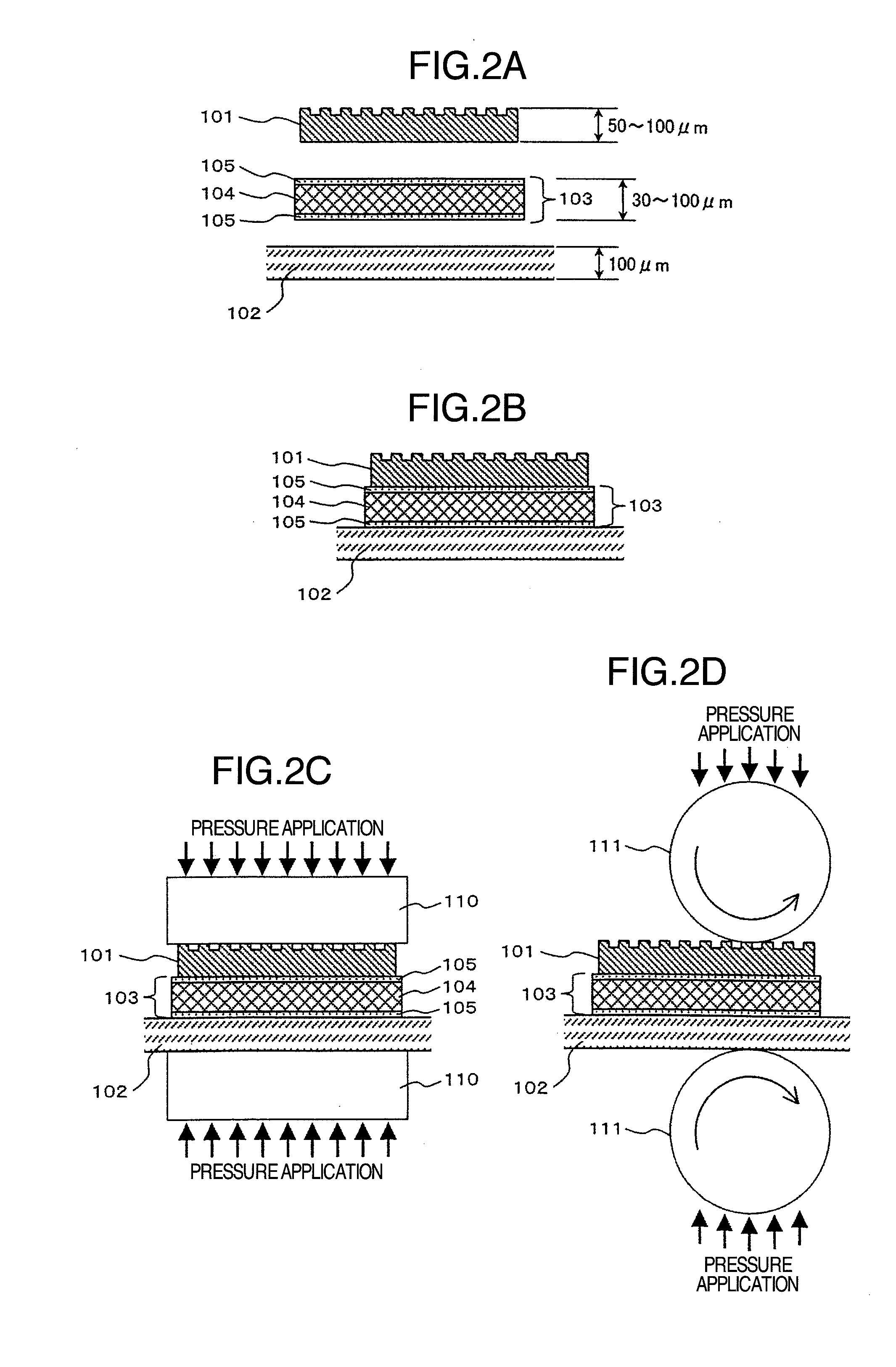Belt-shaped mold and nanoimprint system using the belt-shaped mold
a technology of nano-imprinting and belt-shaped molds, which is applied in the direction of photomechanical equipment, manufacturing tools, instruments, etc., can solve the problems of increasing the cost of associated systems, requiring an extended period, and difficult to fabricate such fine patterns using photolithography, and achieves rapid and stable formation and high aspect ratio.
- Summary
- Abstract
- Description
- Claims
- Application Information
AI Technical Summary
Benefits of technology
Problems solved by technology
Method used
Image
Examples
embodiment 1
[0059]FIGS. 1A to 1C are schematic diagrams illustrating a belt-shaped mold according to a first embodiment of the present invention. Specifically, FIG. 1A is an overall perspective of a belt-shaped mold 100, FIG. 1B is a schematic cross-sectional view of the structure of the belt-shaped mold 100, and FIG. 1C is a schematic cross-sectional view of an adhesive member. For the belt-shaped mold 100, a plurality of stampers 100 having fine, convex-and-concave patterns are arranged along one surface of an endless belt 102. As shown in FIG. 1B, an adhesive member 103 is provided by depositing a layer, made of a thermosetting resin 105, on the obverse and reverse sides of a porous member 104, and is located between the stampers 101 and the endless belt 102. The stampers 101 and the endless belt 102 are fixed by being adhered to the thermosetting resin 105 layers on the obverse and reverse of the adhesive member 103. As shown in FIG. 1C, pores are contiguously formed inside the porous membe...
embodiment 2
[0067]According to a second embodiment of the present invention, the structure of an adhesive member 103 used for a belt-shaped mold 100 will be described in more detail. In the first embodiment, a description has been given on the assumption that the faces of the stampers 101 and the face of the endless belt 102 to be adhered to the adhesive member 103 are sufficiently smooth. However, when the faces of the stampers 101 and the endless belt 102 to adhere to the adhesive member 103 are rough (the surfaces are too uneven to ignore), an unexpected delamination phenomenon may occur due to insufficient adhesiveness with the adhesive member 103.
[0068]The cause of the delamination phenomenon is considered as follows. FIGS. 4A to 4C are schematic cross-sectional views for explaining the cause of the delamination phenomenon that occurs during the manufacture of the belt-shaped mold 100. In the structure illustrated in FIG. 4A, a thermosetting resin 105 is deposited that has the same thickne...
embodiment 3
[0071]For a third embodiment of the present invention, a relationship is required between the sizes of an adhesive member 103 and each stamper 101 of a belt-shaped mold 100. FIGS. 6A and 6B are schematic cross-sectional views for explaining another structural factor applicable to the adhesive member 103 in the structure of the belt-shaped mold 100 of this embodiment. The structure in FIG. 6A is for a thermal bonding time in a case wherein the adhering face of the stamper 101 is the same size as is the adhesive member 103, and the structure in FIG. 6B is for a thermal bonding time in a case wherein the adhering face of the adhesive member 103 is larger than is the stamper 101. It should be noted that “size” represents the size of a projection face, and more specifically, represents the length, in the circumferential direction, of the endless belt 102 and the length in the direction of the width.
[0072]When a thermal bonding process was performed for the structures in FIGS. 6A and 6B, ...
PUM
| Property | Measurement | Unit |
|---|---|---|
| height | aaaaa | aaaaa |
| width | aaaaa | aaaaa |
| aspect ratio | aaaaa | aaaaa |
Abstract
Description
Claims
Application Information
 Login to View More
Login to View More - R&D
- Intellectual Property
- Life Sciences
- Materials
- Tech Scout
- Unparalleled Data Quality
- Higher Quality Content
- 60% Fewer Hallucinations
Browse by: Latest US Patents, China's latest patents, Technical Efficacy Thesaurus, Application Domain, Technology Topic, Popular Technical Reports.
© 2025 PatSnap. All rights reserved.Legal|Privacy policy|Modern Slavery Act Transparency Statement|Sitemap|About US| Contact US: help@patsnap.com



